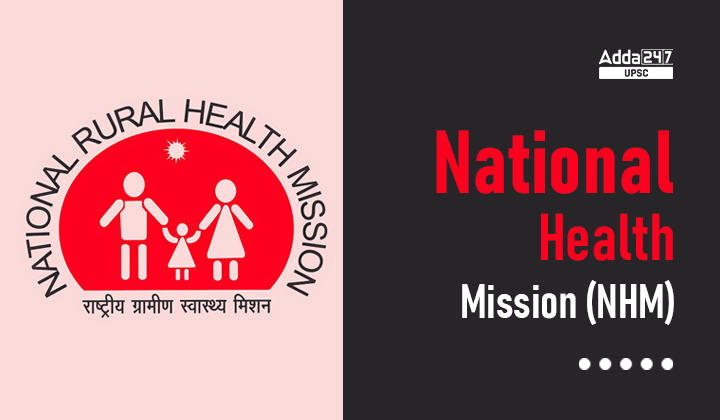Table of Contents
National Health Mission (NHM)- Relevance for UPSC Exam
- GS Paper 2: Governance, Administration and Challenges
- Government policies and interventions for development in various sectors and issues arising out of their design and implementation.
National Health Mission (NHM) in News
- The Union Cabinet, chaired by Prime Minister, Shri Narendra Modi, was apprised about the progress under NHM during FY 2020-21 including accelerated decline in MMR, IMR, U5MR and TFR.
- It also noted the progress in respect of various diseases programmes like TB, Malaria, Kala-Azar, Dengue, Tuberculosis, Leprosy, Viral Hepatitis etc.
National Health Mission (NHM)
- Background: The National Rural Health Mission was launched in 2005 with the objective of building public health systems to provide accessible, affordable and quality health care to the rural population, especially the vulnerable groups, up to the District Hospitals (DH) level.
- In 2012, the National Urban Health Mission (NUHM) was conceptualized and the NRHM was rechristened as the National Health Mission (NHM) with the two Sub Missions viz. the NRHM and the NUHM.
- About: NHM is implemented for universal benefit – i.e. entire population; services are offered to everyone visiting the public healthcare facilities with a special focus to vulnerable section of the society.
- Targets: National Health Mission (NHM) aims to achieve the following objectives-
- Reduce MMR to 90 from 113
- Reduce IMR to 23 from 32
- Reduce U5MR to 23 from 36
- Sustain TFR to 2.1
- Reduce prevalence of Leprosy to <1/10000 population and incidence to zero in all districts
- Annual Malaria Incidence to be <1/1000
- Prevent and reduce mortality & morbidity from communicable, non- communicable; injuries and emerging diseases
- Reduce household out-of-pocket expenditure on total health care expenditure
- Ending the TB epidemic by 2025 from the country.
Implementation Strategy of National Health Mission (NHM)
- The implementation strategy of Ministry of Health and Family Welfare under NHM is to provide financial and technical support to States / Union Territories (UTs).
- It also enables States/UTs to provide accessible, affordable, accountable, and effective healthcare upto District Hospitals (DHs), especially to the poor and vulnerable sections of the population.
- It has also aimed to bridge the gap in rural healthcare services through improved health infrastructure, augmentation of human resource and improved service delivery in rural areas.
- It has envisaged decentralization of programme to district level to facilitate need-based interventions, improve intra and inter-sectoral convergence and effective utilization of resources.
Progress under National Health Mission (NHM)
Progress under NHM during 2020-21 is as under:
- Ayushman Bharat-Health & Wellness Centres: The approvals of 1,05,147 Ayushman Bharat-Health & Wellness Centres were accorded till 31st March 2021.
- 1,17,440 Health & Wellness Centres were operationalized against the cumulative target of 1,10,000 till 31st March, 2022.
- Improvement in Women and Child Health: There has been acceleration in decline of Maternal Mortality Ratio (MMR), Under Five Mortality Rate (U5MR) and the IMR since the launch of the NRHM/NHM.
- U5MR in India has declined from 49 in 2013 to 36 in 2018
- As per SRS 2017-19, MMR has further reduced to 103.
- As per SRS 2020, IMR has further reduced to 28.
- At the current rate of decline, India should able to reach its SDG target (MMR-70, U5MR-25) much before the due year i.e. 2030.
- LaQshya: 202 Labour Rooms & 141 Maternity Operation Theatres are State LaQshya certified and 64 Labour Rooms & 47 Maternity Operation Theatres are National LaQshya certified.
- National Ambulance Services (NAS): As on March 2021, 35 States / UTs have the facility where people can Dial 108 or 102 for calling an ambulance. 735 additional Emergency Response Service vehicles were added in 2020-21.
- During 2020-21, 30 additional Mobile Medical Units (MMUs) were added.
- 24×7 Services and First Referral facilities: During 2020-21, 1140 facilities were added as FRUs operationalization.
- Kayakalp: 10,717 public health facilities received Kayakalp awards under this scheme in 2020-21.
- Malaria: The total number of malaria cases and deaths reported in 2020 were 1,81,831 and 63 respectively in comparison to 11,02,205 cases and 561 deaths reported in 2014, indicating a decline of 83.50% malaria cases and 88.77% deaths in comparison to the corresponding period of 2014.
- Kala–Azar: The percentage of Kala Azar (KA) endemic blocks, achieving the elimination target of < 1 KA case per 10,000 population, increased from 74.2% in 2014 to 97.5% in 2020-21.
- Lymphatic Filariasis: In 2020-21, among 272 LF endemic districts, 98 districts have successfully cleared 1 Transmission Assessment Survey (TAS-1) and stopped MDA and these districts are under Post MDA surveillance.
- Dengue: In relation to Dengue, the National target was to sustain case fatality rate (CFR)<1 percent.
- The target was achieved as case fatality rate in 2014 was 0.3% and during 2015 to 2018, CFR has been sustained at 0.2%.
- Further in 2020, it has been sustained at 0.1% as it was in 2019.
- National Tuberculosis Elimination Programme (NTEP): A total of 1,285 Cartridge Based Nucleic Acid Amplification Test (CBNAAT) machines and 2,206 Truenat machines are operational at district level across the country.
- In 2020, 29.85 lakh molecular tests have been performed. This is 4 times increase as compared to 7.48 lakh during 2017.
- In 2020, 30,605 MDR/RR-TB patients have been initiated on shorter MDR-TB regimen, 10,489 DR-TB patients have been initiated on newer drug containing regimen (Bedaquiline-10,140 and Delamanid-349) throughout country.
- Pradhan Mantri National Dialysis Programme (PMNDP): It was launched in 2016 to support dialysis facilities in all district hospitals in the PPP mode under NHM.
- During FY 2020-21, PMNDP has been implemented in 35 States/UT in 505 Districts in 910 Dialysis Centres by deploying 5781 machines.
- During 2020-21, total 3.59 lakh patient availed dialysis services and 35.82 Lakhs Hemo-dialysis Sessions held.




 TSPSC Group 1 Question Paper 2024, Downl...
TSPSC Group 1 Question Paper 2024, Downl...
 TSPSC Group 1 Answer key 2024 Out, Downl...
TSPSC Group 1 Answer key 2024 Out, Downl...
 UPSC Prelims 2024 Question Paper, Downlo...
UPSC Prelims 2024 Question Paper, Downlo...
